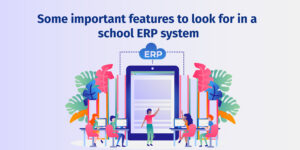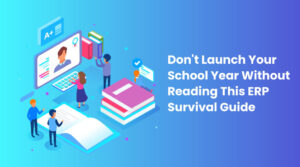
How To Implement an Education ERP
Education ERP (Enterprise Resource Planning) is a comprehensive software system that helps schools, colleges and universities manage various administrative and academic processes. From student and staff management to finance, attendance, and communication, an education ERP streamlines various processes and helps improve the overall efficiency and productivity of an educational institution.
Implementing an education ERP can be a daunting task, but with proper planning and execution, it can bring numerous benefits to your school or university. In this blog, we will look at how to implement an education ERP and the important features that need to be considered.
- Detailed Gap Analysis:
Before implementing an education ERP, it is crucial to conduct a gap analysis to identify the problems and goals of each section of the school. This includes analyzing the current processes and systems in place, identifying areas for improvement, and setting clear goals for the ERP implementation.
- Each section has a goal.
It is essential to identify the problems of each section of the school that the ERP would solve before implementing an education ERP. This includes analyzing the current processes and systems in place, identifying areas for improvement, and setting clear goals for the ERP implementation.
For example, if the school has a manual attendance system in place, the goal of the ERP implementation could be to automate the attendance process so as to improve accuracy and efficiency. Similarly, if the school has a legacy system for student and staff management, the goal could be to migrate to a more comprehensive and user-friendly system.
- Migrate only important data from Legacy Systems:
While implementing an education ERP, it is essential to migrate only the important data from legacy systems. This will help avoid data loss and ensure that all crucial information is available in the new system. It is also essential to properly back up all data before migrating it to the new system to ensure that it is safe and secure.
- Demonstration:
Once the gap analysis is complete, it is crucial to get a demonstration of the education ERP software to understand its features and capabilities. This will help you get a better understanding of how the software can help meet the goals and objectives of your school or university.
- Customizations:
One of the benefits of using an education ERP is the ability to customize it to meet the specific needs and requirements of your school or university. It is essential to discuss customization options with the software vendor to ensure that the ERP meets your school’s needs and is easy to use.
- Maintenance:
Proper maintenance is crucial for the smooth functioning of an education ERP. It is essential to ensure that the software is regularly updated and that any technical issues are promptly addressed. It is also essential to have a dedicated team to handle maintenance and support for the ERP software.
- Implementation:
Once you have finalized the education ERP software and conducted a demonstration, it is time to implement it in your school or university. It is essential to have a dedicated team to oversee the implementation process and ensure that it goes smoothly. It is also crucial to provide proper training to staff and students to ensure that they are comfortable using the new system.
- Testing:
After the education ERP has been implemented, it is essential to conduct thorough testing to ensure that it is working as intended. This includes testing all the features and functions of the software to ensure that they are working correctly. It is also essential to gather feedback from staff and students to ensure that the ERP is meeting their needs and expectations.
- Regular Review and Continuous Enhancement:
Implementing an ERP system is not a one-time event, but a continuous process. It’s crucial to regularly review the ERP functionality to ensure it continues to meet the evolving needs of the institution. This involves assessing the system’s performance, identifying areas for improvement, and working with the ERP vendor to make necessary modifications or enhancements. Regular updates can help optimize the system’s efficiency, improve user experience, and ensure the ERP system remains a valuable tool for the institution. Remember, an ERP system is a dynamic tool that should grow and adapt with your institution.
- Fostering a Culture of Change:
The success of an ERP system is not just about the technology, but also about the people using it. A positive attitude towards change can make a significant difference in the successful implementation and use of the ERP system. It is important to foster a culture of change within the institution to ensure the successful adoption of the new system. This involves preparing the staff for the transition, ensuring adequate training, and assuaging any resistance to change. Open communication about the benefits of the ERP system, as well as the challenges that are likely to arise during its implementation, can help ease the transition.
Conclusion:
In summary, an Education ERP system such as Camu can be a valuable asset for any educational institution. Camu offers features such as a Student Information System, Learning Management System, Integrated SIS & LMS, Virtual Classroom, Camu Mobile Solutions, Outcome Based Education (OBE), Choice Based Credit System (CBCS), Accreditation, and a Controller of Examinations (CoE) module. These features can streamline and automate various administrative and academic processes, enhance communication and collaboration, and provide valuable insights through data analysis. However, it is crucial to carefully evaluate the needs and resources of the institution and select an appropriate ERP solution. The implementation process should involve thorough planning, training, and support to ensure a smooth transition and successful adoption. By following these steps, an education ERP can effectively be implemented to support the growth and success of an educational institution.







